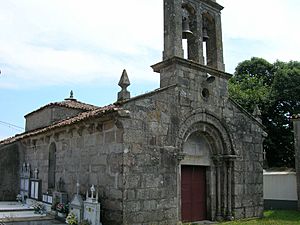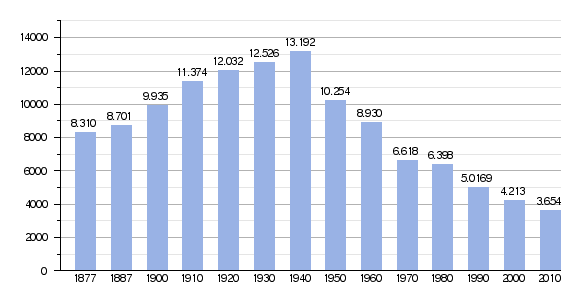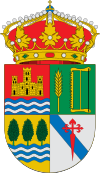Palas de Rei facts for kids
Quick facts for kids
Palas de Rei
|
||
|---|---|---|

Church of Santiago de Albá.
|
||
|
||
| Country | Spain | |
| Autonomous community | Galicia | |
| Province | Lugo | |
| Comarca | A Ulloa | |
| Area | ||
| • Total | 199.68 km2 (77.10 sq mi) | |
| Elevation | 534 m (1,752 ft) | |
| Population | ||
| • Total | 3,414 | |
| • Density | 17.0974/km2 (44.282/sq mi) | |
| Demonym(s) | Palenses | |
| Time zone | UTC+1 (CET) | |
| • Summer (DST) | UTC+2 (CEST) | |
| Postal code |
27200
|
|
| Dialing code | 982 | |
Palas de Rei is a small town in northwestern Spain. It's located in the province of Lugo, within the region of Galicia. This town is part of an area called A Ulloa. As of 2018, about 3,414 people live there. People from Palas de Rei are called Palenses.
Contents
History of Palas de Rei
The history of Palas de Rei is full of ancient stories. It has many old archaeological sites. These include dolmens (ancient stone tombs) and forts. These show that people lived here a very long time ago.
The King's Palace
The town's name, Palas de Rei, means "Palace of the King." It's believed to come from "Pallatium regis." This refers to a palace of the Visigothic king Witiza. He ruled between the years 702 and 710. Legend says that King Witiza killed Duke Favila in Palas. Favila was the father of Don Pelayo, a famous Spanish hero.
The Way of St. James
The Camino de Santiago (also known as The Way of St. James) greatly influenced Palas de Rei. This famous pilgrimage route brought the Romanesque style of architecture to the area. You can see this style in many old churches.
Church of Vilar de Donas
One important example is the Church of Vilar de Donas. It's a key example of Galician Romanesque art. In 1931, it was declared a historical-artistic monument. Its wall paintings are some of the best and most well-preserved in Galicia.
Medieval Times
An old Roman road called "Lucus Augusti" passed through this area. By the 6th century, Palas de Rei was part of the "Ulliensis" county. The Middle Ages were a time of growth for the town. This was thanks to the Camino de Santiago. The "Codex Calixtino," an important medieval guide for pilgrims, mentioned Palas. It said it was a necessary stop for pilgrims on their way to Santiago de Compostela.
Historical Buildings and Castles
Palas de Rei has many old buildings that show its noble past. You can find remains of:
- Old forts
- Towers
- Castles
- Many mansions and grand houses with family crests
Important Structures
Some of the most important buildings include:
- The old house-tower of Filgueira.
- The tower-house of Fontecuberta.
- The Pazo de Laia, which has the coat of arms of the Counts of Traba.
- The house of Ulloa, where important families like the Saavedra and Montenegros lived.
- The Pazo Mariñao.
- The old fortress of Castro de Seixas in Merlán parish.
- The Pazo de Pacheco.
Pambre Castle
One of the best examples of military architecture in Galicia is the Castle of Pambre. Don Gonzalo Ozores de Ulloa built this strong fortress in 1375. It was so strong that it survived a major revolt in 1467.
Demography: How the Population Changed
Demography is the study of how populations change over time. This includes how many people live in a place and how that number goes up or down.
The chart below shows how the population of Palas de Rei has changed over many years. You can see that the population was much higher in the early 1900s and has slowly decreased over time.

International Connections
Palas de Rei has special friendships with other towns around the world. These are called "twin towns" or "sister cities." It's a way for communities to learn from each other and share cultures.
Twin Towns
Palas de Rei is twinned with:
 Plouha, a town in Brittany, France. This partnership started in 2003.
Plouha, a town in Brittany, France. This partnership started in 2003.
See also
 In Spanish: Palas de Rey para niños
In Spanish: Palas de Rey para niños



